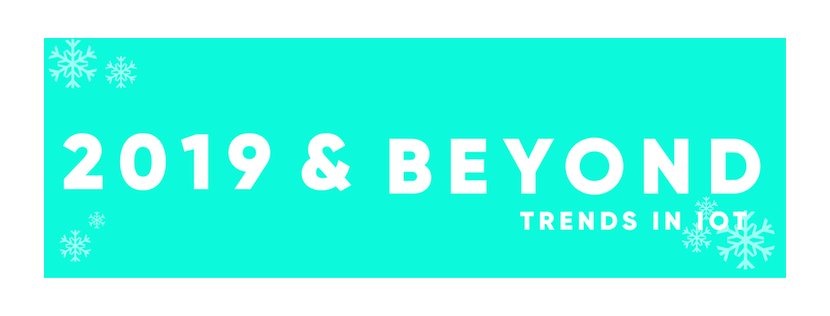
The Internet of Things (IoT) space grew quickly in 2018 and spending on digital products and services is expected to double by 2021. As industries continue looking for new ways to meet consumer and production demands, digital products and services will continue to grow exponentially. Here are some of the trends we’re seeing as an IoT systems integrator that works closely with our partners like IBM and Google.
Machine learning will move from narrow to general intelligence
There are two levels of machine learning, or what most of us call artificial intelligence (AI): narrow and general. Narrow AI has the ability to complete a very niche task, such as transcription, or suggest purchases based on previous behaviors. Even today’s self-driving cars use only narrow AI in a coordinated pattern. The second level, or artificial general intelligence, can process and reason in a way that makes it nearly indistinguishable from a human. With Google’s recent announcement that Google Duplex can make hair appointments and order pizzas, machine learning is closer than ever to passing the Turing Test, or becoming indistinguishable from a human being.
Increased digital transformation in all industries
The full transition to cloud computing has proven challenging for some businesses, and as a result, we’re seeing growth in a hybrid-cloud approach. This could mean using both on-premise and cloud, or using multiple clouds to achieve the solution that works best for your organization. While moving to the cloud has been a trend for years, nearly a third of IT spending in 2022 is expected to be cloud-based software and services, meaning that every industry is adopting this new way of procuring IT infrastructure and software.
Enhanced customer experiences mean chatbots are on the rise
Thanks to enhanced natural language processing capabilities and AI’s ability to reason better than years before, we will see big leaps in customer service “chatbots”, which simulate real agents in an attempt to more quickly find solutions to customer problems. This can help enhance customer service experiences in crucially differentiating ways. In fact, 70 percent of customers said they’d use a chatbot if they could resolve issues quickly, 24 hours a day, 7 days a week. Even better, chatbots reduce the annoying aspects of contacting customer service, specifically teleprompts. Frequently, customers don’t feel frustrated with chatbots because they feel their voices are being heard and understood, even if it means being transferred to a human representative. The results are so promising that Oracle recently found 80 percent of brands plan to use chatbots by 2020.
Market saturation of “smart cars” and connected platforms
The auto industry has been steadily gaining speed with connected car platforms and machine learning assistants in today’s vehicle models. Upcoming auto releases will have more of these capabilities, allowing things like personal assistants in vehicles. Imagine your car knowing that you’re tired and directing you to the next coffee shop, then ordering and paying for your drink before you even arrive!
5G is here, and infrastructure must be prioritized
We’re already seeing cities like Indianapolis, Atlanta, Dallas, and others gain access to 5G networks, which allows data centers to process information fast enough for things like self-driving cars and other IoT products to work how we want. Currently, cities are battling service providers for locations and zoning control, holding back widespread adoption, but moving into 2020 this should be made a priority. 5G is the first network access that could help make autonomous vehicles safer and more secure because the vehicle has more efficient access to the data needed to make decisions.
Instead of reports to analyze, IoT will provide suggestions using data
The hype around collecting data just to have it is over. Now, organizations must use that data in a way that allows them to make business decisions affecting the bottom line, like preventive maintenance, customer satisfaction, and more. Predictive analytics will only advance in years to come, so that industries like manufacturing and logistics not only get the data they need, but are able to analyze the data and uncover suggested actions.
Use of blockchain to increase customer confidence
Blockchain technology isn’t only about cryptocurrency, and it can be applied in many industries. As an effective backend, more IoT products and services can use this as a way to secure data and keep customer data private — especially in smart cars, smart home devices, etc. We will see more exploration of blockchain technology this year and into 2020 to add transparency to our supply chains, track ownership, and more. For example, food recalls could be virtually eliminated by using blockchain with nanotechnology sensors to track food origin and shipment.
Autonomous data centers that prevent server outages
The International Data Corporation (IDC) estimates that by 2020, today’s apps and IT architectures will force 55 percent of large organizations to upgrade existing data centers, or deploy new centers entirely. Currently, most data centers are ill-equipped to perform at the rate of innovation or consumer demand. Enterprises can benefit in the long run by being proactive and deploying data centers with autonomous elements. Using IoT sensors and products that provide information about hardware nearing the end of its shelf life can prevent costly repairs and the need for 24/7 on-call engineers in the event of an outage.

